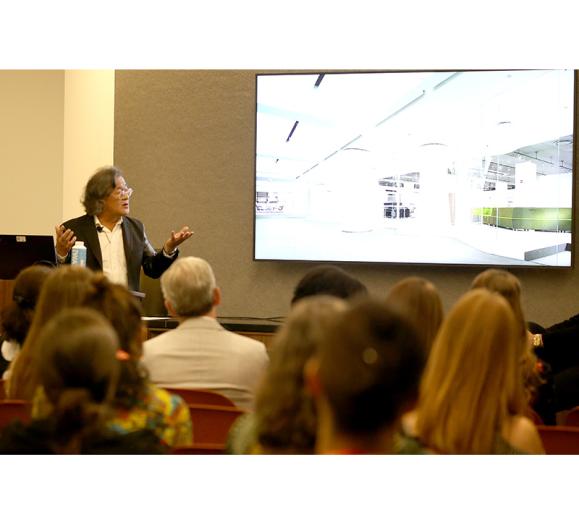On a gray Parisian afternoon in July above the cafes of Montmartre, French tightrope artist Tatiana-Mosio Bongonga placed one delicate foot in front of the other. Below, an orchestra played as she walked 115 feet up into the towering domes of the Sacre Coeur basilica as spectators watched anxiously. Bongonga walked unaccompanied — no security equipment, not even a net below her. She relied on self-confidence in her ability to stay completely centered.
When bringing on new clients, interior designers walk a tightrope of their own, but their confidence can only push them so far. With so many competitors trying to woo potential clients — everything from e-design services like Homepolish, to Restoration Hardware offering complimentary design services in their stores — transparency is also key, helping designers stay true to their value and land the clients that respect the designer’s expertise and time. Here’s how to walk the line.
Charge For Consultations — Seriously
In a conference room at the DeSoto Hotel in Savannah, GA, last May, interior designers at the ART + IDS Conference broke into small groups and traded tips and gripes. The seminar functioned like speed dating: Each group talked about a certain topic for a short amount of time, and when time was up, they moved to a different table and started again with a new group, a new topic and a new leader. At business coach Nancy Ganzekaufer’s table, the discussion quickly turned to consultation fees when one designer admitted she didn’t charge for them.
To Ganzekaufer, not charging a consultation fee might as well be a cardinal sin. She believes it devalues the designer’s service and expertise, and by charging for that initial meeting, designers set client perceptions and expectations.
First, she says, fees will weed out the tire kickers, the designers’ biggest time wasters. These clients haven’t committed to the service, and right now, they’re just looking for information more than anything. There’s nothing inherently wrong with just wanting information — except when it’s on your dime. A tire kicker could become a great client, but not until he or she can make the investment in your expertise.
Charging the fee also allows designers to feel comfortable with whatever they say at the consultation. There’s less pressure to perform, to try reading the client and to guess what type of design will make him or her sign on. Think the walls should be painted red? Say so. Want to knock down a few walls? Throw it out there and see if it sticks.
“You can really be creative, which is what a designer should be, and let it flow and now worry about, ‘Well I shouldn’t be saying this because they didn’t pay me yet,’” says Ganzekaufer.
And if the clients decide to take the ideas the designer suggested and implement them on their own? So what. The designer still gets paid and feels less resentment and rejection when a client doesn’t call back. But in Ganzekaufer’s experience, the designers that lay out their vision of the space and hold nothing back end up getting the clients in the end.
“You’re able to really be yourself, which to me is part of being authentic,” Ganzekaufer says. “That is the best part.”
Price Your Worth and Stand By It
Dallas interior designer Nicole Arnold knows what her time is worth, but how she explains her pricing hasn’t always been the same. Several years ago, when a plumbing fixture company left an invoice at a client’s home, the client compared it to the invoice he’d received from Arnold and didn’t like what he saw. Even though Arnold got a better deal on the plumbing fixtures than the client would have been able to get on his own, he didn’t understand the mark up.
So Arnold explained the mark up and the process. She ordered the product and made sure it was delivered. When everything arrived, she compared the parts with the purchase order and ensured everything matched. She handled all the peripheral pieces of the project that the clients might have overlooked. But the client didn’t understand why he needed to pay for services she rendered, and he insisted that he could have done it all himself.
Arnold apologized for the miscommunication, but she stood by her work. The parts didn’t just appear. Arnold spent her time and money ensuring the order came correctly, and she felt her modest markup was reasonable. The ordeal ended in a soured relationship, but it taught Arnold a valuable lesson in price transparency. She amended her contract to better represent what her costs covered and moved on.
David Adler, a Chicago-based lawyer with extensive experience in contract interpretation, has had clients with similar problems and some with costly mistakes. He’s had clients come to him with no contract at all and others with contracts so lengthy they might have been written by Apple. His clients have started out doing design for a friend and ended up fighting that same friend in the courtroom. Of all the parts of the contract, the payments clause can be the biggest minefield for designers if it’s not worded well.
“Any time you deal with money, it always raises everybody’s hackles,” he says.
No matter what pricing model a designer chooses, be it hourly or a design fee, the contract should briefly explain it, and designers should be ready to elaborate when clients have questions. But that doesn’t mean designers need to explain every penny spent.
“When you go into Macy’s to buy something,” Ganzekaufer explains, “you don’t ask them, ‘How much did you pay for it and how much is your overhead and how much do you pay your employees and why am I paying so much?’”
Adler, who also spoke at the ART + IDS Conference this year, agrees. He says contracts need to clarify how and when a client will be charged, but not exactly how much everything will cost and what the designer’s profit will be.
“From my perspective, transparency means that the client understands the relationship,” he explains. “The client understands what the scope of the services are. The client understands what the client is paying for and might be expected to pay for.“
It may seem obvious, but some clients don’t understand that custom orders differ from most consumer online shopping. There’s a lot that goes into the process — and a lot that can go wrong. Discussing the legwork of the project will help clients see the value in a designer and better understand what they’re paying for. There’s more than one way to do this.
“I really try to understand either what their field of work is or their past experience with designers or some things about them so I can give them really relevant analogies and set them at ease,” Arnold says.
Ganzekaufer recommends including an FAQ section in a welcome packet that better explains the services clients are getting by working with a designer. Of all the information available on the internet, in magazines and on social media, many first-time clients simply don’t know what working with a designer entails, but when they learn, Arnold says they usually see the value. In the last six months, she says she’s only turned away one client who she felt would not be a good fit for her services.
“My business is 90 percent referral,” she explains. “So whoever is referring them has shared their experience, and they understand from that perspective what kind of service we offer.”
Never Having To Always Say Yes
The hallmark of confidence in a designer is knowing when to walk away from new business. When a prospective client pushes back against her pricing and suggests doing some of the ordering themselves, Arnold gives them the speech.
“I’ll say, ‘You know, this service is not for everyone. It’s a luxury service. It’s for people who appreciate this work being done for them because they would rather focus their time on the things they’re best at and the things they enjoy doing and let us do what we’re good at. And in the end, you have a great experience and you can enjoy your purchases and your investment.’”
Some clients agree, and Arnold never hears from them again. But sometimes, she hears what happened next. Not long ago, Arnold went out on a consultation to meet a couple who seemed ready and willing to work with her. When it came time to discuss payment, the clients insisted that they only pay for furniture even after Arnold explained her pricing. Arnold stood her ground, but the clients couldn’t see her value and ended up shopping at the newly opened Nebraska Furniture Mart.
Not surprisingly, things didn’t work the way the clients hoped they would. On top of poor service, the products they ordered didn’t fit the space, and nothing arrived on time.
Arnold’s confidence allows her to be more transparent with her clients, and she and her team always look for new ways to better themselves. She attends High Point every year, and she’s developed good relationships with manufacturers. Despite her numerous awards, she continues to improve her craft through CEU and other educational courses. When she feels like she might be swaying on her tight rope, her experience, expertise and confidence help her regain her balance.
“When people spend money, they want to know they’re investing in someone who has confidence in what they’re doing,” Arnold relates. “Otherwise, they’re going to have an unsettled feeling. Money is a hard subject for a lot of people to talk about, and the more confident a designer can be in explaining the value that’s behind why they’re charging, the more successful they’ll be.”







